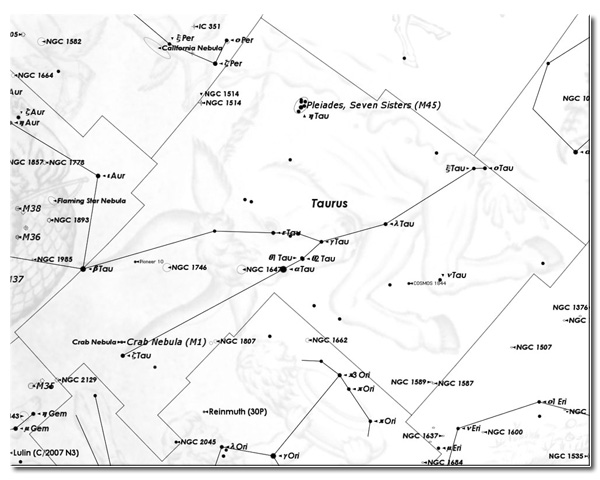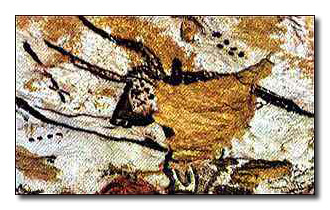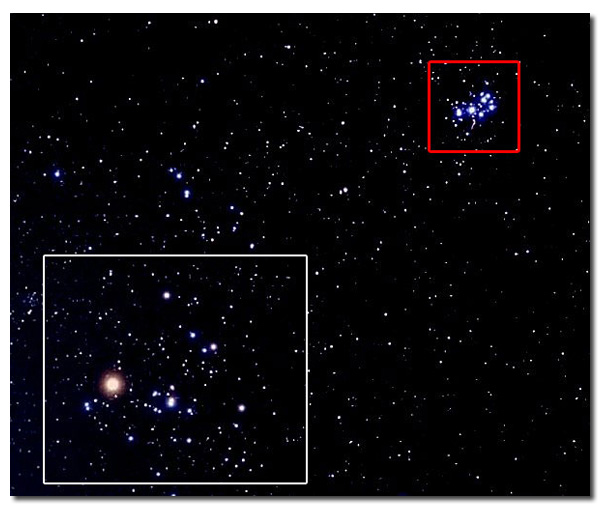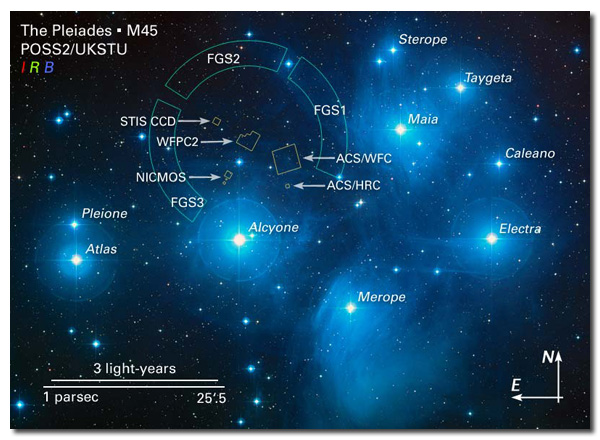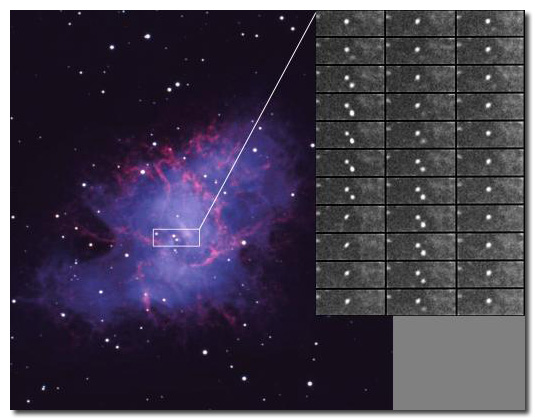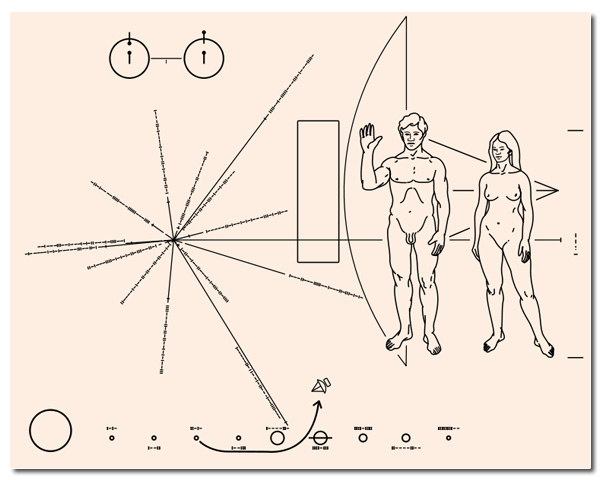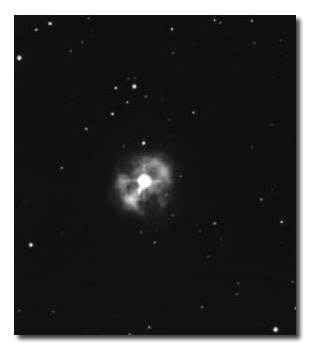As first appeared in the November 2009 edition of the Syracuse Astronomical Society newsletter The Astronomical Chronicle (PDF).
Constellation Map generated with Starry Night Pro 6.
This month's constellation is one of the best in the Night Sky for combining ancient tradition, mythology, modern astronomy, world history, stellar eye candy, and even modern engineering into one reasonably small bordered pen of celestial real estate. The early evening sight of the constellation Taurus the Bull in the November southeast sky at Darling Hill might appear to CNY viewers as a snow divining rod pointing to the western Great Lakes in anticipation of winter and the upcoming lake-effect snow. Taurus is a distinctive constellation and very easy to identify once its central asterism is identified. The brightest star in the constellation is almost equidistant from the easily identified Pleiades and the shoulder of the constellation Orion, the celestial hunter Taurus is running from as the sky appears to move (or, from the most commonly drawn orientation, right towards him!). While Taurus is mildly sparse in quantity when it comes to dark sky objects, it more than makes up for it in quality, hosting two of the most significant stellar sights in the Night Sky.
Like its neighbor Orion, Taurus the Bull is a very, very old constellation and has been recognized as a bull for the duration of its existence in Middle Eastern and European traditions. Earliest records of any kind place the birth of Taurus in the Copper (Chalcolithic) Age (4500 – 3500 B.C.E.), although some records support its existence even earlier. The presence of a bull and what appears to be a Pleiades-like star formation exists on a wall in the Lascaux Caves of France (see right). Although the interpretation of the Constellation set is controversial, this arrangement may date back as far as 16,500 years. Personally, I find even the thought of that kind of continuity between what we might see in the winter skies and what our ancestors also saw at night both comforting and humbling. Many of the same stand-out patterns we know today no doubt stood out immediately to them as the brightest objects in the sky marked out regular places as the Sun set, and the great distance we've traveled in history might be barely perceptible to an ancient astronomer going simply by the positions of stars.
Lascaux Cave bull and star pattern. From the Institute for Interdisciplinary Studies and spacetoday.org.
We begin the tour by aiming our sights at the bright eye of the bull, the star Aldebaran. This orange giant is 44 times the diameter of our own Sun and has already used its hydrogen fuel, leaving this fusion engine to now graze on a steady diet of helium. Its name is derived from the Arabic for "the follower," often reported as in reference to its position below the Pleiades (so "following" this open cluster as we progress into winter). The other stars in Taurus are easy to see in darker skies but not otherwise noteworthy for their brightness at either naked-eye or binocular viewing magnification. Several of the bright stars closest to Aldebaran make up an asterism that a new observer might confuse with the complete constellation. The V-shaped Hyades (center of the image below and shown at right with white border) are composed of five stars, with Aldebaran the brightest tip. I'll admit that the first time I marked out the space for Taurus, I confused this asterism (and lambda-Tau to the west) with the entire object before double-checking the size. No bull. The Hyades star closest to Aldebaran, theta-Tau, is actually a pair of pairs, although they only appear as a single bright pair in binoculars and telescopes.
The Hyades (white) and Pleiades (red). From Lynn Laux, nightskyinfo.com.
Caught within the bull pen is the Pleiades (M45, shown labeled below from a Hubble image). This Tiny Dipper is visible year-round during the daytime in parking lots and slow-moving traffic everywhere (as the object embedded within the emblem on every Subaru, the Japanese name for this asterism) and is one of the treats of winter viewing in CNY (unless VERY early morning viewing is your game or you've been trying to see Mars in the late Summer skies, in which case you've been enjoying the pre-dawn sight of M45 since August). The amount of information available on the Pleiades online and as part of space research could easily (and very likely has) fill an entire book. While the seven bright stars are identified from Greek mythology as the Seven Sisters (Sterope, Merope, Electra, Maia, Taygete, Celaeno, and Alcyone), the counting aid that comes from a pair of binoculars easily reveals nine stars. The two stars that make up the handle of this tiny dipper are the proud parents Atlas and Pleione, placed to the east of the dipper to protect their daughters from either Taurus (for being a bull) or Orion (for being a male). Given the long history of this asterism, it is perhaps not surprising that the parents decided not to stop at seven. In fact, there are over 1,000 distinct stars in the Pleiades that have been revealed as part of multiple high-resolution studies. This density of stars makes the Pleiades a unique open cluster, as there is a wealth of stars and patterns visible at virtually any magnification, from small binoculars to the largest ground-based telescopes. For my first proper viewing session, I spent one full hour simply looking at this cluster through my Nikon 12×50's, amazed at just how little we really see of the Night Sky using the 1×7 binoculars built into our heads (and, perhaps, corrected by horn-rimmed glasses).
The Pleiades in detail. Image from hubblesite.org and wikipedia.org
On the opposite side of Taurus and caught between the horns is the first of the categorized Messier objects, the Crab Nebula. M1 to its friends, this nebula is a supernova remnant with a remarkable history. As documented in both Arab and Chinese texts (Europe was just coming out its, er, Dark Ages at the time), this supernova was so bright on July 4, 1054 that it was visible during daylight hours (and, as you can guess by the date, visible without any magnification). The supernova remnant we know today as the Crab Nebula was discovered (and correlated to the original supernova) first by John Bevis in 1731, then by Charles Messier in 1758 while, as it happens, observing a comet (that Messier is known best for his catalogue of objects that were NOT comets instead of the comets he worked so diligently to discover is one of the great fun ironies of astronomy). The NASA images of the Crab Nebula reveal a dense sponge-like structure full of filaments of all sizes. The image above shows a remarkable sight – the full cycle of the pulsar at the heart of the crab that continues to magnetically drive the expansion of the nebula (in the series of frames, the pulsar lies below and to the right of a constant-brightness star).
The Crab Nebula pulsar. Image from www.strw.leidenuniv.nl
Stepping forward several hundred years, Taurus also marks the present locations of Pioneer 10 and COSMOS 1844. Pioneer 10 is currently speeding in the direction of Aldebaran, having been successfully steered through the asteroid belt to make a series of images of Jupiter. At its current velocity, this trip to Aldebaran's current location would take 2 million years, about the same amount of time it might take most of the world to decipher the meaning of the emblematic plaque attached to its exterior (below). Perhaps someday we'll have to explain to the aliens how a civilization that could launch a complicated probe into space couldn't see the multitude of planets in their own Solar System, then perhaps have to explain what happened to Pluto hat it no longer appears in our Solar System images. COSMOS 1844 is one of over 2440 satellites launched by the Soviet Union (and now Russia) since the first of the COSMOS series in 1962. At mag. 5, this satellite makes for a fun artificial viewing target (with a good map in hand).
The Pioneer 10 plaque. From wikipedia.org.
The final sights for telescope viewers include four NGC objects. NGC 1746, 1647, and 1807 are open clusters with magnitudes between 6 and 7. NGC 1514 (below) is a mag 10 planetary nebula just at the far edge of the Taurus border that should be increasingly good viewing as Taurus works its way towards our zenith (1514 will be the closest it will get to our zenith by midnight, a perfect last-good-look before Darling Hill completely freezes over).
NGC 1514. From Martin Germano, seds.org)
Phenomenal viewing at a reasonably safe distance. Just be mindful not to wave your red flashlights at Aldebaran!
www.syracuse-astro.org
http://en.wikipedia.org/wiki/Taurus_%28constellation%29
http://en.wikipedia.org/wiki/Divining_rod
http://en.wikipedia.org/wiki/Great_Lakes
http://en.wikipedia.org/wiki/Lake_effect_snow
http://en.wikipedia.org/wiki/Orion_%28constellation%29
http://en.wikipedia.org/wiki/Chalcolithic
http://en.wikipedia.org/wiki/Lascaux_Caves
www.spacetoday.org/SolSys/Earth/OldStarCharts.html
http://en.wikipedia.org/wiki/Aldebaran
http://en.wikipedia.org/wiki/Hyades_%28star_cluster%29
http://www.nightskyinfo.com/archive/hyades/
http://en.wikipedia.org/wiki/Pleiades_%28star_cluster%29
http://www.subaru.com/
http://en.wikipedia.org/wiki/Mars
http://en.wikipedia.org/wiki/Sterope_(Pleiad)
http://en.wikipedia.org/wiki/Merope
http://en.wikipedia.org/wiki/Electra_(Pleiad)
http://en.wikipedia.org/wiki/Maia_(mythology)
http://en.wikipedia.org/wiki/Taygete
http://en.wikipedia.org/wiki/Celaeno
http://en.wikipedia.org/wiki/Alcyone_(star)
http://en.wikipedia.org/wiki/Atlas_(mythology)
http://en.wikipedia.org/wiki/Pleione_(mythology)
http://en.wikipedia.org/wiki/Crab_Nebula
http://en.wikipedia.org/wiki/Dark_Ages
http://en.wikipedia.org/wiki/John_Bevis
http://en.wikipedia.org/wiki/Charles_Messier
http://www.nasa.gov
http://www.strw.leidenuniv.nl/~oberg/Pulsars/external.html
http://en.wikipedia.org/wiki/Pioneer_10
http://en.wikipedia.org/wiki/Jupiter
http://en.wikipedia.org/wiki/Pluto
http://en.wikipedia.org/wiki/Cosmos_%28satellite%29
http://en.wikipedia.org/wiki/Pioneer_plaque
http://server1.wikisky.org/starview?object_type=4&object_id=241&object_name=NGC+1746&locale=EN
http://server1.wikisky.org/starview?object_type=4&object_id=211&object_name=NGC+1647&locale=EN
http://server1.wikisky.org/starview?object_type=4&object_id=279&object_name=NGC+1807&locale=EN
http://seds.org/~spider/ngc/ngc.cgi?NGC1514
